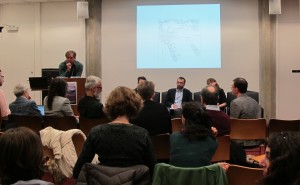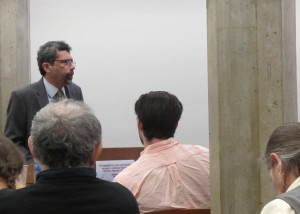In Empire’s Long Shadow: Modern Constructions of Central Eurasia, 1900-1941
by Robert Bird
In recent years the University of Chicago has become home to a group of innovative young scholars—both faculty and PhD students—working on issues related to the modern construction of new cultural institutions, practices and histories in  Central Eurasia. Supported by faculty from a range of departments, these PhD students have rejuvenated the Committee on Central Eurasian Studies and maintained a lively program of events. On 26-27 February 2016 the University hosted a major international conference designed to showcase their work and bring them into dialogue with leading senior scholars in the field, as well as with colleagues within the Committee for Central Eurasian Studies and from across the University.
Central Eurasia. Supported by faculty from a range of departments, these PhD students have rejuvenated the Committee on Central Eurasian Studies and maintained a lively program of events. On 26-27 February 2016 the University hosted a major international conference designed to showcase their work and bring them into dialogue with leading senior scholars in the field, as well as with colleagues within the Committee for Central Eurasian Studies and from across the University.
All twenty presentations examined aspects of Central Eurasian history and culture at a time when empires crumbled in the wake of World War I and revolutionary transformation rocked the entire territory, from Iran and the Turkish Republic to the Soviet republics of Central Asia and Transcaucasia and across Xinjiang, Mongolia, and Siberia. Political developments and the formation of national institutions were accompanied by rapid changes in culture, most strikingly in language, literacy, gender and religion. By the beginning of World War II, Central Eurasia had taken shape as a set of ethnically-defined territorial units. Papers examined both this unprecedented political order and the equally unprecedented cultural forms it engendered.
The tone of discussion was set by two keynote lectures, delivered at the start of each day’s proceedings by Nergis Ertürk from the Department o
f Comparative Literature at Pennsylvania State University and Adeeb Khalid from the Department of History at Carleton College. Professor Ertürk presented a section from her book-in-progress on Turkish communist and ex-communist writers educated in the Soviet Union during the 1920s and 1930s, a project that cuts across the divide between Ottoman/Turkish and Russian/Soviet studies. She focused on Life’s Good, Brother: A Novel by Nazım Hikmet (1901-1963), a globally acclaimed communist poet and playwright, who spent the final decade of his life in Soviet exile, after being freed from imprisonment by the Turkish government between 1938 and 1950. The novel’s modernist narrative techniques belie its seemingly autobiographical basis, making it less an account of the origins of the Turkish communist movement and more an analysis of the particular kinds of writing produced within this movement, an analysis that Professor Ertürk contrasted to Nazım’s 1925 essay on the need for a communist press, which drew heavily on writings by Lenin. Lenin’s and Nazım’s calls for a communist press—specifically, a newspaper—rested on a peculiar “communist grammatology,” which assumed language to be a homogeneous connective medium: “In its seriality, which extends it through both space and time, the newspaper’s form draws its force from, and materializes in print, the structure of repetition inherent in writing.”
In his later novel, by contrast, Nazım uses a paratactic style that “introduces and accentuates gaps at the level of syntax and narrative organization.” This new grammatology is represented by an X that the protagonist draws on the door of his prison cell, a sign of the rhetorical figure of chiasmus, which Paul de Man defined as the “cross-shaped reversal of properties.” In this later work, then, “each repetition is an iteration across a gap that does not eliminate that gap as much as it accentuates it. In this context, there is no horizon to cross, no revolution imminent, no determinate end at all.”
From her spectacular analysis of Nazım’s novel Professor Ertürk drew two larger conclusions concerning Central Eurasian studies as a field. First, she proposed to treat Eurasia as a space of translation, in which texts exist always across linguistic and political divides. Second, that in his later grammatology Nazım anticipated the predicament of post-communism, opening a liminal space within the historical present for a new inception of communism.
Opening the second day, Adeeb Khalid offered reflections on the field of Central Eurasian studies based on the life of Abdurauf Fitrat (1886-1938), founder of modern Uzbek literary culture, drawing on his recent book Making Uzbekistan: Nation, Empire, and Revolution in the Early USSR (Cornell University Press, 2015). Born in Bukhara, Fitrat studied in Istanbul, where he formulated his defense of modern education for Muslims, encapsulated in the credo: “Strive until you too have that which made the Christians victorious over you.” While there he also adopted Turkism, which led him to welcome the revolution (though not Bolshevism) as a means of liberating Central Asia from imperial rule. Among other things, Fitrat was the main theorist behind the reimagination of the sedentary Muslim population of the region as Uzbek.
Concluding his detai led and witty narration of Fitrat’s life and works, Professor Khalid proposed several major theses. Although Fitrat was certainly shaped by the Russian and Ottoman empires, “much of what Fitrat did was outside of imperial institutions, not enabled by them.” In fact, the case of Fitrat forces us to regard not only Central Eurasian states, but also local society in all of its complexity. Therefore, the promise of revolution for Central Eurasia was not necessarily tied to communism or Bolshevism, but for Fitrat and others presented opportunities to pursue goals dictated by other ideological systems, like Turkism. It is therefore imperative, Professor Khalid concluded, that colonial history not limit itself to linear relationships between center and periphery, but also take into account contestations within the colonized society.
led and witty narration of Fitrat’s life and works, Professor Khalid proposed several major theses. Although Fitrat was certainly shaped by the Russian and Ottoman empires, “much of what Fitrat did was outside of imperial institutions, not enabled by them.” In fact, the case of Fitrat forces us to regard not only Central Eurasian states, but also local society in all of its complexity. Therefore, the promise of revolution for Central Eurasia was not necessarily tied to communism or Bolshevism, but for Fitrat and others presented opportunities to pursue goals dictated by other ideological systems, like Turkism. It is therefore imperative, Professor Khalid concluded, that colonial history not limit itself to linear relationships between center and periphery, but also take into account contestations within the colonized society.
Both keynote speakers concurred on the need for scholars in Central Eurasian studies to provide alternatives to the nationalist narratives that quickly became definitive for post-imperial Central Eurasian states, and which remain dominant throughout the region in our day. For Adeeb Khalid, Fitrat’s story underscores the impossibility of any kind of authenticity “beyond the reach of empire and of historical change.” For Nergis Ertürk, Nazım’s modernist narrative not only underscores the fluid national, cultural and linguistic boundaries of Central Eurasia, but also suggests “a critical epistemology and a politics resistant to the authoritarian nationalisms and pan-ethnic identitarianisms of the region.” These propositions were amply demonstrated and extended in many of the papers delivered during the conference—and the vibrant discussion that invariably followed—on topics ranging from Lāhūtī’s appropriation of Persian poetics (Samuel Hodgkin) to the creation of a pantheon of Uygur heroes in communist China (Joshua Freeman), and from “millionaire kolkhozes” in the Ferghana Valley (Flora Roberts) to parallels between the Hamidian massacres in the Ottoman Empire and pogroms in the Russian Empire (Toygun Altintas).
In addition to the Center for East European and Russian/Eurasian Studies and the Committee on Central Eurasian Studies, the program was made possible through the generous support of a number of units and centers at the University of Chicago: The Center for International Studies Norman Wait Harris Fund, The Franke Institute for the Humanities, and the departments of Comparative Literature, History, Near Eastern Languages and Civilizations, and Slavic Languages and Literatures.
For more on the conference, see: https://lucian.uchicago.edu/blogs/empireshadow/
